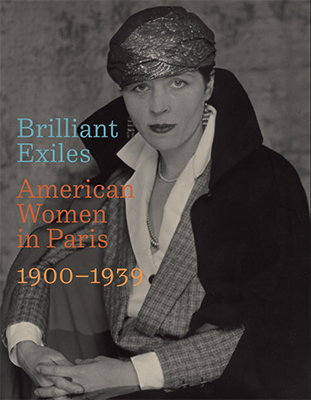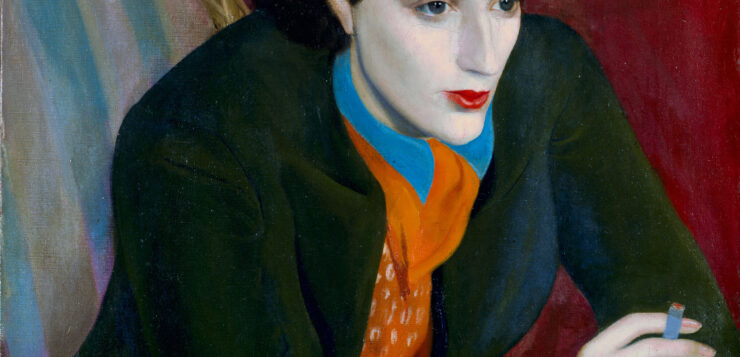 BRILLIANT EXILES
BRILLIANT EXILES
American Women in Paris, 1900-1939
National Portrait Gallery
Catalog edited by Robin Asleson
Yale Univ. Press. 288 pages, $55.80
THE SMITHSONIAN’S National Portrait Gallery has forged new paths in scholarship and history with its exhibition Brilliant Exiles: American Women in Paris, 1900–1939, which is showing there until next February (after which it travels to Georgia). Thanks are owed to the second-wave feminists who shone a light on many of the women included in the current show.
Before the feminist revolution of the 1970s, most women who followed their dreams to Paris were missing from the standard art history texts, such as that of H. W. Janson. Second-wave feminist scholarship changed all that because of pioneers like Cindy Nemser, a founder of Women in the Arts and The Feminist Art Journal, in 1972; Cynthia Navarreta’s “Women Artist’s Newsletter” (1975); Eleanor Tufts’ Our Hidden Heritage: Five Centuries of Women Artists (1974), Tee Corinne’s Cunt Coloring Book (1975); Ann Sutherland Harris and Linda Nochlin, co-curators of Women Artists:1550–1950 (1976), and so many others who rolled up their academic sleeves, dug through dusty archives, tracked down relatives, and located paintings long lost to the history of art, restoring many extraordinary Modernist women to the pantheon of American art alongside the men whose works are more familiar to us.
Curator Robyn Asleson’s introductory essay, “Transatlantic Transformations,” captures the central themes of this far-reaching exhibition and the relative freedom that living and studying in Paris gave to American women audacious enough to leap at the opportunity stretching before them. Take, for example, the work of queer artist Margaret Lefranc (1907–1998), whose story captures what drove many women, regardless of race, class, ethnicity, or sexual orientation, to Paris during this period: freedom and opportunity. Asleson takes pains to point out how these women shaped international Modernism.
T. Denean Sharpley-Whiting’s “Genealogy of Expatriation: When Paris Was a Black Woman” adds an essential dimension to Asleson’s discussion of transatlantic Modernism. Given the “stultifying effects of racial discrimination and segregation that Black people experienced in the United States,” it’s little wonder that many women artists and intellectuals of color escaped to Paris. Women of color—including aviator Bessie Coleman, writer Jessie Redman Fauset, sculptors Augusta Savage and Meta Vaux Warrick, entertainer and spy Josephine Baker, and nightclub owner and singer Ada “Bricktop” Smith—blossomed under the sunshine of a freedom that was foreign to Jim Crow America.

Zakiya R. Adair delineates how American dancers, singers, and entertainers electrified and transformed vaudeville, cabaret, and music hall entertainment while simultaneously reinforcing the “negrophilia fantasies” of the nonwhite body that go back to the time of Delacroix. Tirza True Latimer talks about “the Found Generation” in Paris while illuminating the brilliant contributions of several lesbians: dancers Loïe Fuller and Beatrice Wagner, salonist and writer Natalie Barney, and artist Romaine Brooks. Polly Thayer Starr’s 1936 portrait of writer May Sarton (left), who discovered her lesbianism while in Paris, captures Sarton’s sardonic and sometimes grandiose intensity.
As music and dance historian Samuel N. Dorf points out, the importance of ancient Greek dance underscores the impact of classical myths, drama, singing, theater, and dance upon these women. He illustrates his essay with a much-reproduced photograph of the love story of the Greek lyric poet Sappho performed in Natalie Barney’s garden at Neuilly. The subject is the tragedy of Sappho’s abandonment by her young lover, who marries a man. Dorf discusses the centrality of Barney to modern dance, as well as Eva Palmer-Sikelianos, who was instrumental in reviving the Delphic Festival of Greek theater, dance, and music.
Brilliant Exiles represents the culmination of years of research and study to restore the suppressed history of America’s female moderns. It belongs on the shelf of any reader interested in the cultural legacy of this period and beyond. The Brilliant Exiles exhibit is free and available at the National Portrait Gallery until February 23, 2025, and travels to the Georgia Museum of Art, Athens, July 19 to November 2, 2025.
Cassandra Langer, a freelance writer based in New York City, is the author of Romaine Brooks: A Life.






